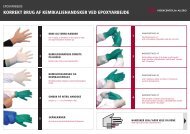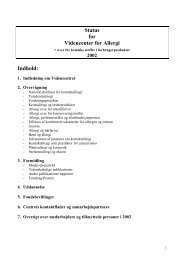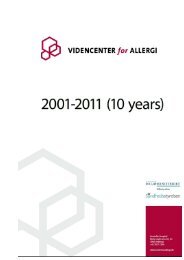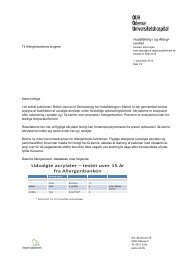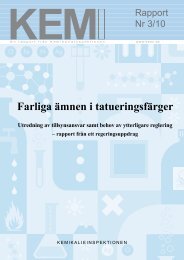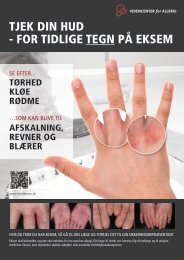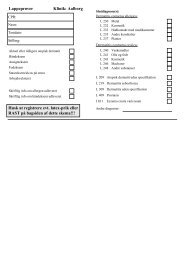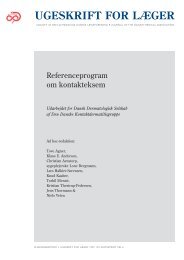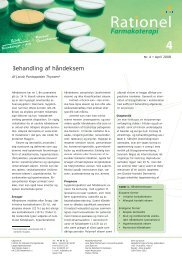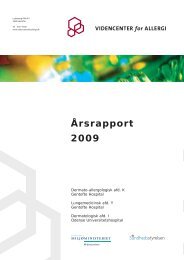Charlotte Devantier Jensen.pmd - Videncenter for Allergi
Charlotte Devantier Jensen.pmd - Videncenter for Allergi
Charlotte Devantier Jensen.pmd - Videncenter for Allergi
Create successful ePaper yourself
Turn your PDF publications into a flip-book with our unique Google optimized e-Paper software.
Contact allergy to the preservative methyldibromoglutaronitrile 25<br />
GENERAL DISCUSSION AND FUTURE PERSPECTIVES<br />
The more we know of the mechanisms of allergic contact dermatitis,<br />
the better the disease may be managed and prevented.<br />
The overall purpose of this thesis was to study some aspects<br />
of allergic contact dermatitis and contribute to the safe use of<br />
new and existing chemicals utilized in cosmetics and household<br />
products. The study consisted of 3 clinical elicitation trials<br />
with the preservative and contact allergen MDBGN.<br />
Elicitation studies on sensitized patients are a very important<br />
means of determining safe use-levels and investigating the<br />
behaviour of allergens without sensitizing healthy volunteers.<br />
If an allergen level is safe <strong>for</strong> the majority of sensitized individuals<br />
it may also be assumed safe with regard to induction 102 .<br />
In parts of this study the results were intended <strong>for</strong> use in a reevaluation<br />
of the use-levels of MDBGN, while in others<br />
MDBGN was used as a model allergen and parallels may be<br />
drawn to other allergens.<br />
In the trials of this thesis, different features of MDBGN were<br />
examined. In summary, it was, based on the results, concluded<br />
that:<br />
– MDBGN in rinse-off products can elicit allergic contact<br />
dermatitis in sensitized individuals.<br />
– multiple daily exposures to MDBGN appear to accumulate.<br />
– skin areas with previous allergic contact dermatitis from<br />
MDBGN are hyperreactive to re-exposure both by patch<br />
testing and in a use test even though the skin appears clinically<br />
healed.<br />
Parts of the results may be allergen-dependent, while others<br />
may apply to allergens in general.<br />
The EU Commission has prohibited the use of MDBGN in<br />
leave-on cosmetics until a safe use-level can be determined.<br />
This has by industry been suggested to be in the range of 0.005-<br />
0.010% (50–100 ppm) MDBGN 44 . However, in a recent clinical<br />
elicitation study a moisturizer containing 0.005% MDBGN<br />
easily elicited dermatitis in more than half of the sensitized<br />
test persons 103 . As the allergenic potency of this chemical has<br />
become apparent, the existence of an acceptable use concentration<br />
of MDBGN in leave-on products with adequate antimicrobial<br />
effect is being questioned. Thus, a future unconditional<br />
prohibition of MDBGN in leave-on products is probable.<br />
A safe use of MDBGN in rinse-off products needs further<br />
investigation.<br />
The results presented here, along with the reported cases of<br />
allergic contact dermatitis from rinse-off products containing<br />
MDBGN, indicate that the currently permitted level of<br />
MDBGN in rinse-off products is too high. The probability of<br />
sensitization occurring in a use-situation with prolonged, frequent<br />
use of a rinse-off product containing MDBGN cannot<br />
be disregarded. MDBGN in liquid hand soaps is of special<br />
concern. This is <strong>for</strong> several reasons. 1) In Denmark and probably<br />
the EU in general, MDBGN is widely used as preservative<br />
in liquid hand soaps. Liquid hand soaps have a high water<br />
content and hence require an efficient preservation. This is<br />
obtained with MDBGN explaining its popularity of use in these<br />
products. 2) The hands may be susceptive to exposure as it is<br />
not uncommon <strong>for</strong> the skin of the hands to be damaged to some<br />
degree from repeated exposure to irritants and water from frequent<br />
hand washing, house work, or various occupational exposures.<br />
3) Hand soaps contain detergents which have been<br />
shown to increase the exposure response. 4) It is not unusual<br />
to use a hand soap multiple times in a day and according to<br />
our results this appears to generate a cumulated exposure. 5)<br />
We have shown in two studies that MDBGN in the maximum<br />
allowed concentration in a liquid soap can easily elicit allergic<br />
contact dermatitis in sensitized individuals, and case reports<br />
indicate that MDBGN-containing hand soaps may also sensitize.<br />
6) Moreover, hand eczema is a potentially very problematic<br />
condition that in severe cases may be accompanied by<br />
long-term sick leave and <strong>for</strong>ced job rehabilitation. On the basis<br />
of these results and considerations, we recommend a reevaluation<br />
of the existing threshold limiting value of MDBGN<br />
in rinse-off products<br />
The determination of safe exposure levels of chemicals in<br />
contact with the skin and an implementation of these in the<br />
legislation is an essential means to prevent allergic contact<br />
dermatitis in the population. Examples of allergens where legislative<br />
regulation have had a clearly preventive effect are<br />
nickel, potassium chromate and Kathon CG. In 1992 a nickelregulation<br />
was implemented in Denmark reducing the allowed<br />
nickel-release threshold from nickel-containing alloys and<br />
coatings that are in prolonged contact with the skin. This threshold<br />
was determined at a level where only a minority of nickelsensitized<br />
individuals will react with dermatitis. In a study of<br />
ear-pierced school girls, a decrease in nickel-sensitization was<br />
seen when the piercing had been per<strong>for</strong>med after the regulation<br />
was implemented 102 . A similar regulation has now been<br />
adopted by the EU. Chromate allergy is frequently caused by<br />
occupational exposure to cement. In Denmark it has been mandatory<br />
to add ferrous phosphate to cement since 1983 in order<br />
to reduce the amount of water-soluble chromate and this has<br />
lead to a decrease in chromate sensitivity in workers exposed<br />
to cement from 8.9% in 1981 to 1.3% in 1987 104 . Another example<br />
is the previously mentioned cosmetic preservative<br />
Kathon CG that caused an epidemic of allergic contact dermatitis<br />
in the 80’s and early 90’s. A down-regulation of the allowed<br />
use-level of the active ingredient in cosmetic products<br />
induced a significant decline in the frequency of sensitivity to<br />
the substance.<br />
Fragrances are, following nickel, the second most common<br />
cause of allergic contact dermatitis in Europe 105 and regulatory<br />
action is urged to improve this circumstance. A regulatory<br />
measure will come into effect in March 2005 which requires<br />
manufacturers to list 26 fragrance chemicals with known<br />
allergenic potential on the product label if present above a certain<br />
concentration in the product. Currently, it is sufficient to<br />
declare that the product contains perfume. This prophylactic<br />
measure allows sensitized persons to avoid the relevant fragrance<br />
chemicals and prevent outbreaks of allergic contact<br />
dermatitis. A primary prophylaxis is however preferable and it<br />
should be attempted to avoid or minimize sensitization. In the<br />
ef<strong>for</strong>t to determine safe use concentrations, several elicitation<br />
studies have been per<strong>for</strong>med with known allergenic fragrance<br />
chemicals in recent years 8,9,106-109 .<br />
The establishment of safe threshold levels <strong>for</strong> allergenic cosmetic<br />
ingredients, like preservatives and fragrance chemicals,<br />
is an extensive task requiring a lot of resources. Additionally,<br />
acceptance and implementation of safe use levels into legislation<br />
is a long and slow process. This is however an important<br />
objective that will be accompanied by significant social and<br />
economical benefits.<br />
Forum <strong>for</strong> Nord Derm Ven Vol. 10, 2005 – Suppl. 8




